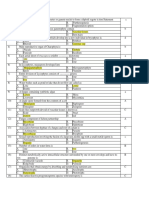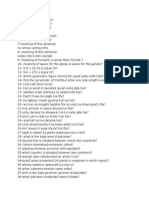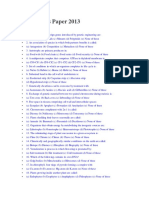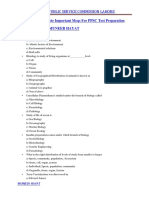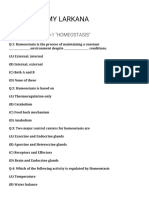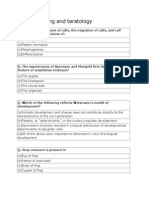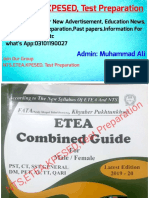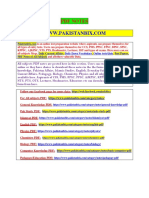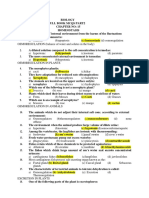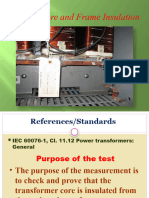Biology Mcqs
Biology Mcqs
Uploaded by
karnatisharathCopyright:
Available Formats
Biology Mcqs
Biology Mcqs
Uploaded by
karnatisharathOriginal Description:
Copyright
Available Formats
Share this document
Did you find this document useful?
Is this content inappropriate?
Copyright:
Available Formats
Biology Mcqs
Biology Mcqs
Uploaded by
karnatisharathCopyright:
Available Formats
No building was made in a day;keep working till it matches your dream
1. The Galapagos Islands are associated with the visit of
(a) Jean Lamarck
(b) Charles Darwin
(c) Gregor Mendel
(d) Alfred Wallace
Ans. (b)
2. Which of the following was most influential upon Darwins formulation of theory of natural
selection?
(a) De Vries concept of mutation
(b) Wallaces paper on survival
(c) Malthuss essay on population
(d) Lamarcks on inheritance of acquired characters
Ans. (c)
3. Survival of the fittest was used by
(a) Charles Darwin
(b) Jean Baptiste Lamarck
(c) Hugo deVries
(d) Herbert Spencer
Ans. (d)
4. After observing the variations HUGO DE VRIES first of all described the mutation in
(a) Oenothera lamarl.4ana
(b) Neurospora crassa
(c) Pisum sativum
(d) Drosophila melanogaster
Ans. (a)
5. According to scientists, the Big Bang occurred approximately ? years ago.
(a) 100 million
(b) 100 thousand
(c) 1 billion
(d) 15 billion
Ans. (d)
6. PASTEUR succeeded in disproving the spontaneous generation theory because
(a) he was lucky
(b) he was ingenious in drawing out the neck of glass flasks, so as to provide access to air but not to
microorganisms
(c) of the fact that sample of yeast taken by him was dead
(d) of the clear surrounding of his laboratory
Ans. (b)
7. The first organisms were
(a) primitive eukaryotes
(b) aerobic bacteria
(c) prokaryotic
(d) photosynthetic
Ans. (c)
8. Why was the primitive atmosphere of Earth more beneficial to the origin of life than the modern
atmosphere of Earth?
(a) The primitive atmosphere had a layer of ozone that shielded the first delicate cells
(b) The primitive atmosphere was reducing one that facilitated the formation of complex
substances from simple molecules
(c) The primitive atmosphere was an oxidising one that facilitated the formation of complex
substances from simple molecules
(d) The primitive atmosphere has less free energy than the modern atmosphere, and thus newly
If you lose; Dont forget when you were sleeping someone else was working hard
No building was made in a day;keep working till it matches your dream
formed organisms were less likely to be destroyed
Ans. (b)
9. Russian scientist who proposed the theory of origin of life was
(a) Oparin
(b) Miller
(c) Haldane
(d) Fox
Ans. (a)
10. In their laboratory simulation of early Earth, Miller and Urey observed the abiotic synthesis
(a) amino acids
(b) coacervates
(c) DNA
(d) liposmes
Ans. (a)
11. The richest source of fossils is
(a) basalt
(b) granite
(c) lava
(d) sedimentary rock
Ans. (d)
12. Biologists who study the sequences of organisms in the fossil record are
(a) taxonomists
(b) palaeobiologists
(c) misologists
(d) systematists
Ans. (b)
13. Which were dominant in Mesozoic?
(a) Dinosaurs
(b) Gymnosperms
(c) Fishes
(d) Mammals
Ans. (a)
14. The Golden age of Reptiles was
(a) Late Paleozoic
(b) Cenozoic
(c) Mesozoic
(d) Proterozoic
Ans. (c)
15. The fossil remains of Archaeopteryx is a connecting link between
(a) amphibians
(b) reptiles and birds
(c) fish and amphibians
(d) reptiles and mammals
Ans. (a)
16. Which of the following set is the evidence of evolution?
(a) Homologous and vestigial organs
(b) Analogous and vestigial organs
(c) Homologous and analogous organs
(d) All of the above
Ans. (a)
If you lose; Dont forget when you were sleeping someone else was working hard
No building was made in a day;keep working till it matches your dream
17. Of the following anatomical structures, which is homologous to the wing of a bat?
(a) The arm of a human
(b) The wing of a butterfly
(c) The tail of a fish
(d) The dorsal fin of a shark
Ans. (a)
18. Which one of the following sets of structures includes only analogous organs?
(a) Wings of butterfly, housefly and bat
(b) Hind legs of horse
(c) Hands of man, monkey and kangaroo
(d) Mandibles of cockroach, mosquito and honeybee
Ans. (a)
19. Which of the following set represents all vestigial structures in the human body?
(a) Vermiform appendix, body hair and cochlea
(b) Wisdom teeth, coccyx and patella
(c) Coccyx, vermiform appendix and muscles of ear pinna
(d) Body hair, muscles of ear pinna and atlas vertebra
Ans. (c)
20. The earliest animal to have been domesticated by man most likely the
(a) horse
(b) pig
(c) dog
(d) cow
Ans. (c)
21. Presence of gill slits in the embryo of all vertebrates supports the theory of
(a) organic evolution
(b) recapitulation
(c) metamorphosis
(d) biogenesis
Ans. (b)
22. Appearance of ancestral characters in the new borne, such as tail, multiple mammae, etc., are
known as
(a) homologous
(b) analogous
(c) atavistic
(d) vestigial
Ans. (c)
23. Evolution is defined as
(a) history of race
(b) development of race
(c) history and development of race with variations
(d) progressive history of race
Ans. (c)
24. The book named Philosophic zoologique was published in 1809 and was written by:
(a) Mendel
(b) Darwin
(c) De Vries
(d) Lamarck
Ans. (d)
25. Penguin is a bird that lost the use of its wings by not flying. Such a statement would express the
views of
If you lose; Dont forget when you were sleeping someone else was working hard
No building was made in a day;keep working till it matches your dream
(a) Darwin
(b) Wallace
(c) Lamarck
(d) Huxley
Ans. (c)
....................................................---------------------------.................................................................
Solved Biology questions and Answers Objective Type
Objective Type Biology Questions and Answers to test your Skills and Serve as practice Test paper
These Biology Questions Contain Botany and Zoology
1. Mesophyll tissue is well differentiated into spongy tissue and palisade tissue in
(a) Dicot leaves
(b) Ophytic stem
(c) Hydrophytic stem
(d) Monocot leaves
Ans. (a)
2. Lateral meristem is responsible for
(a) Growth in parenchyma
(b) Growth in thickness
(c) Growth in cortex
(d) Growth in length.
Ans. (b)
3. As a tree grows older, which increases more rapidly in thickness?
(a) Sapwood
(b) Cortex
(c) Phloem
(d) Heartwood
Ans. (d)
4. What is the other name for the cork tissue?
(a) Phellogen
(b) Phelloderm
(c) Phellem
(d) Periderm
Ans. (c)
5. Commercial cork is obtained from the species of
(a) Berberis
(b) Quercus
(c) Salix
(d) Betula
Ans. (b)
6. The cross-section of a trunk of a tree showed 50 annual rings. The age of tree is
(a) 50 years
(b) 50 months
(c) 100 years
If you lose; Dont forget when you were sleeping someone else was working hard
No building was made in a day;keep working till it matches your dream
(d) 25 years
Ans. (a)
7. Trees at seashore do not have annual rings because
(a) There is climatic variation
(b) There is no marked climatic variation
(c) There is enough moisture in the atmosphere
(d) Soil is sandy
Ans. (b)
8. Grafting is not possible in monocots because they
(a) Have scattered vascular bundles
(b) Have parallel venation
(c) Are herbaceous
(d) Lack cambium
Ans. (d)
9. A tissue is a
(a) A group of separate organs that are co ordinate in their activities
(b) Group of similar cells tat function together in a specialized activity
(c) Layer of cells surrounding an organ
(d) Sheet of cells, one layer thick
Ans. (b)
10. Which type of tissue forms the inner lining of a blood vessel?
(a) Epithelial
(b) Connective
(c) Muscle
(d) Nervous
Ans. (a)
11. Epithelial tissue with thin flat cells appearing like packed tiles occur on
(a) Inner lining of stomach
(b) Inner lining of fallopian tube
(c) Inner lining of cheek
(d) Outer surface of ovary
Ans. (c)
12. The actively dividing layer of columnar cells in the epidermis of man is called as the
(a) Stratum granulosum
(b) Stratum lucidum
(c) Stratum malpighi
(d) Stratum comeum
Ans. (c)
13. Horns of most mammals are composed of
(a) Bones
(b) Cartilage
(c) Keratin
(d) Chitin
Ans. (c)
If you lose; Dont forget when you were sleeping someone else was working hard
No building was made in a day;keep working till it matches your dream
14. Mammary glands are modified
(a) Sebaceous gland
(b) Sweat gland
(c) Oil gland
(d) Lymph gland
Ans. (b)
15. Which of the following tissue has matrix, which is the source of its structural and functional
performances?
(a) Connective tissue
(b) Muscular tissue
(c) Nervous tissue
(d) Epithelial tissue
Ans. (a)
16. Ground substances and fibers in the connective tissue are the secretory products of
(a) Mast cells
(b) Reticular cells
(c) Plasma cells
(d) Fibroblasts
Ans. (d)
17. The camels hump is composed of a tissue that provides water when oxidized
(a) Skeletal
(b) Areolar
(c) Muscular
(d) Adipose
Ans. (d)
18. The white fibrous tissue occurs in
(a) Ligaments
(b) Cartilage
(c) Tendons
(d) Bone
Ans. (c)
19. Ligaments are made up of
(a) White fibers and some yellow elastic fibers
(b) White fibers only
(c) Yellow fibers only
(d) Yellow fibers and muscle fibers
Ans. (a)
20. The major constituent of vertebrate bone is
(a) Calcium phosphate
(b) Potassium hydroxide
(c) Sodium chloride
(d) Calcium carbonate
Ans. (a)
21. A bone left in dilute HCI for about three days will
(a) Crack into pieces
If you lose; Dont forget when you were sleeping someone else was working hard
No building was made in a day;keep working till it matches your dream
(b) Become soft and elastic
(c) Dissolve completely
(d) Remain as it is
Ans. (b)
22. Haversian system is typically found in bones of
(a) Fishes
(b) Ayes
(c) Reptiles
(d) Mammals
Ans. (d)
23. The bone of a mammal contains Haversian canals, which are connected by transverse canals
known as
(a) Semicircular canals
(b) Inguinal canals
(c) Volkmanns canals
(d) Bidders canals
Ans. (c)
24. Blood is
(a) Acidic
(b) Alkaline
(c) Variable
(d) Neutral
Ans. (b)
25. Mammalian erythrocytes are
(a) circular
(b) Biconcave
(c) Non-nucleated
(d) All the above
Ans. (d)
26. Life span of RBC is
(a) 50 days
(b) 75 days
(c) 120 days
(d) 100 days
Ans. (c)
27. Which one of the following blood pigments contains copper?
(a) Haemoerythrin
(b) Haemocyanin
(c) Chlorocruorin
(d) Haemoglobin
Ans. (b)
28. Which of the following tissues in a human being uses the greatest amount of energy?
(a) Vascular tissue
(b) Muscular tissue
(c) Nervous tissue
If you lose; Dont forget when you were sleeping someone else was working hard
No building was made in a day;keep working till it matches your dream
(d) Epithelial tissue
Ans. (b)
29. Striped muscle fiber has
(a) Many nuclei
(b) Two nuclei
(c) No nuclei
(d) One nucleus
Ans. (a)
30. When we lift hand
(a) The triceps contracts and the biceps relaxes
(b) The biceps contracts and the triceps relaxes
(c) Both biceps and triceps contract
(d) Both biceps and triceps relax
Ans. (b)
31. In human, increased heat production is achieved most rapidly by increase the activity of the
(a) sweat gland
(b) Liver
(c) Skeletal muscle
(d) Brain
Ans. (c)
32. Smooth muscle fibers are
(a) spindle-shaped, unbranched, non striated, multinucleate and involuntary
(b) spindle-shaped, unbranched, unstriated, uninucleate and involuntary
(c) Cylindrical, striated, unbranched, multinucleate and voluntary
(d) Cylindrical, unbranched, non-striated, multinucleate and involuntary
Ans. (b)
33. Muscles, which are immune to fatigue, are
(a) Unstriped muscles
(b) Cardiac muscles
(c) Jaw muscles
(d) Skeleton muscles
Ans. (b)
34. Schwann cells and nodes of Ranvier are found in
(a) Neurons
(b) Chondroblasts
(c) Osteoblasts
(d) Gland cells
Ans. (a)
35. Schwann cells and nodes of Ranvier are found in
(a) Neurons
(b) Chondroblasts
(c) Osteoblasts
(d) Gland cells
Ans. (a)
If you lose; Dont forget when you were sleeping someone else was working hard
No building was made in a day;keep working till it matches your dream
36. Afferent nerve fiber carries impulses from
(a) Effectors to central nervous system
(b) Receptor to central nervous system
(c) Central nervous system to muscle
(d) Central nervous system to receptors
Ans. (b)
37. The strongest muscle in the body is present in
(a) Arm
(b) Jaw
(c) Thigh
(d) Neck
Ans. (b)
38. Cardiac muscle is made of brar1hed fibers that
(a) Nonstriated and under voluntary control
(b) Striated and not under voluntary control
(c) Nonstriated and not under voluntary control
(d) Striated and under voluntary control
Ans. (b)
39. Which of the following tissues in mammals show the least capacity for regeneration?
(a) Endothelium of blood vessels
(b) Skeletal tissue of long bones
(c) Nervous tissue of brain
(d) Epithelial tissue
Ans. (c)
40. Nerve impulses are conducted towards the cell body by
(a) Axons
(b) Ganglia
(c) Dendrites
(d) Neurons
Ans. (c)
41. The study of fish culture is called
(a) Ophiology
(b) Ichthyology
(c) Herpetology
(d) Pisciculture
Ans. (d)
42. Catla and rohu are examples of
(a) freshwater fish
(b) marine fish
(c) brackish water fish
(d) none of these
Ans. (a)
43. Silver Revolution is associated with the increase in the production of
(a) meat
(b) cereals
If you lose; Dont forget when you were sleeping someone else was working hard
No building was made in a day;keep working till it matches your dream
(c) eggs
(d) milk
Ans. (c)
44. The technique in which the developing embryo (at definite stage) from a pregnant superior breed
is removed and transferred to another female with inferior characters, in whose body further
development till birth takes place
(a) Embryo transfer
(b) Artificial insemination
(c) Protoplast fusion
(d) Cloning
Ans. (a)
45. Fever, inflammation of the mucous membranes, particularly the intestines, discharges from the
eyes and nose, dehydration, and skin eruptions on the back and flanks; death comes after four to
eight days. These are the major symptoms of
(a) rinderpest
(b) anthrax
(c) foot and Mouth Disease
(d) cholera
Ans. (a)
46. The Jersey bull used for cross breeding is exotic variety from
(a) USA
(b) UK
(c) Switzerland
(d) Holland
Ans. (a)
47. The IPN (Infectious Pancreatic Necrosis) and VMS (Viral Hemorrhagic Septicemia) are well known
infectious diseases of
(a) fish
(b) cattle
(c) poultry
(d) none of the above
Ans. (a)
48. Mehsana and Jaffarabadi are examples of
(a) Indian breeds of buffaloes
(b) breeds of cow
(c) breeds of sheep
(d) Indian breeds of goat
Ans. (a)
49. The production of useful aquatic plants and animals like prawns, fish, lobsters, crabs, molluscs,
etc., using various types of water resources is called
(a) aquaculture
(b) pisciculture
(c) silviculture
(d) silver revolution
Ans. (a)
If you lose; Dont forget when you were sleeping someone else was working hard
No building was made in a day;keep working till it matches your dream
50. Human genome contains about
(a) 10,000 nucleotides
(b) 10,000 genes
(c) 6 billion nucleotides
(d) 6 billion genes
Ans. (c)
....................................................--------------------------......................................................................
Solved Biology questions For PMT
PMT test in Indiais for Taking Admission in Medical and Dental Colleges
The Test For PMT consisits of Objective Bilogy Consisting of Zoology and botany
Present Test Contains Biology Questions to help You in PMT
1. External protective tissues of plants are
(a) Cortex and epidermis
(b) Pericycle and cortex
(c) Epidermis and cork
(d) Pericycle and cork
Ans. (c)
2. Bulliform cells are present
(a) In upper epidermis of dicot leaves
(b) In lower epidermis of monocot leaves
(c) In upper epidermis of monocot leaves
(d) In dicot stem
Ans. (c)
3. The youngest layer of secondaryh1oem in woody dicot stem is located
(a) Just outside the vascular cambium
(b) Just on the inner side of cambium
(c) Between periderm and primary cortex
(d) Just outside pith
Ans. (a)
4. The wall of cork cells is mostly impregnated with
(a) Cutin
(b) Suberin
(c) Lignin
(d) Hemicellulose
Ans. (b)
5. Cork cells are
(a) Photosynthetic
(b) Elongated and participate in movement
(c) Meristematic
(d) Dead
Ans. (d)
6.Dendrochronology is the study of
(a) Height of a tree
(b) Age of a tree by counting the number of annual rings in the main stem
If you lose; Dont forget when you were sleeping someone else was working hard
No building was made in a day;keep working till it matches your dream
(c) Diameter of a tree
(d) Age of tree by counting the number of leaves in the main stem
Ans. (b)
7. The best method to determine the age of tree is
(a) To measure its diameter
(b) To count the number of leaves
(c) To count the number of annual rings in the main stem at the base
(d) To measure its height
Ans. (c)
8. If the sign was nailed to the side of a tree 5 above the ground in 1997 how high would the sign be
in 2007 if the tree grew 4 taller each year?
(a) 5 high
(b) 8 high
(c) 4 8
(d) 94
Ans. (a)
9. Safranin stains which element of the tissues?
(a) Starch elements
(b) Lignified elements
(c) Bast
(d) Protein elements
Ans. (b)
10. Which types of tissue form the thin surface for the gas exchange in the lungs?
(a) Epithelial
(b) Connective
(c) Nervous
(d) Muscle
Ans. (a)
11. Endothelium of the inner surface of blood vessels in vertebrates is
(a) Simple squamous epithelium
(b) Columnar epithelium
(c) Cuboidal epithelium
(d) Ciliated cells
Ans. (a)
12. The epithelium best adapted for abody surface subject to abrasion is
(a) Simple squamous
(b) stratified squamous
(c) stratified columnar
(d) Simple cuboidal
Ans. (b)
13. In man thickest skin is found in
(a) Palm
(b) Thigh
(c) Sole
If you lose; Dont forget when you were sleeping someone else was working hard
No building was made in a day;keep working till it matches your dream
(d) Thumb
Ans. (c)
14. Which type of tissue forms glands?
(a) Epithelial
(b) Connective
(c) Nervous
(d) Muscle
Ans. (a)
15. Sebaceous glands are found in
(a) Dermis of skin of mammals
(b) Epithelium of stomach of frog
(c) Epithelium of intestine of frog
(d) Epidermis of skin of mammals
Ans. (a)
16. Which type of tissue forms the framework of the external ear?
(a) Epithelial
(b) Connective
(c) Muscle
(d) Nervous
Ans. (b)
17. Wrinkling in old age is due to
(a) Collagen
(b) Myosin
(c) Keratin
(d) Actin
Ans. (a)
18. Which one of the following directly helps in keeping the body warm?
(a) Sweat glands
(b) Adipose tissue
(c) Connective tissue
(d) Hairs
Ans. (b)
19. The fibrous tissue, which connects the two bones, is
(a) Connective tissue
(b) Ligament
(c) Tendon
(d) Adipose tissue
Ans. (b)
20. Tendon connects
(a) Cartilage with muscles
(b) Bone with muscles
(c) Ligament with muscles
(d) Bone with bone
Ans. (b)
If you lose; Dont forget when you were sleeping someone else was working hard
No building was made in a day;keep working till it matches your dream
21. Bone forming cells are
(a) Osteoblasts
(b) Osteoclasts
(c) Chondroblasts
(d) Chondroclasts
Ans. (a)
22. A man was brought up at sea level while his brother spent all his life at an altitude of 10,000 feet.
The latter will have
(a) More active bone marrow
(b) Lower blood pressure
(c) Less subdermal fat
(d) More active sweat glands
Ans. (a)
23. A bone is distinguished from cartilage by the presence of
(a) Collagen
(b) Lymph vessels
(c) Blood vessels
(d) Haversian canals
Ans. (d)
24. Which one of these is a kind of tissue?
(a) Lung
(b) Kidney
(c) Blood
(d) Pancreas
Ans. (c)
25. Nissls granules are found in cyton of nerve cells. These have affinity for basic dyes. The granules
are made up of
(a) Proteins
(b) DNA
(c) Amino acids
(d) RNA
Ans. (d)
26. In camel, erythrocytes are
(a) Oval and nucleated
(b) Circular, biconcave and nucleated
(c) Oval and non-nucleated
(d) Circular, biconcave, non-nucleated
Ans. (b)
27. Iron in hemoglobin exists as
(a) Unionized iron atom
(b) Ferric ions only
(c) Ferrous ions only
(d) Ferric or ferrous ions depending upon the oxygenate state of the heme moiety
Ans. (c)
If you lose; Dont forget when you were sleeping someone else was working hard
No building was made in a day;keep working till it matches your dream
28. Red cell count is carried out by
(a) Haemocytometer
(b) Haemoglobinometer
(c) Sphygmomanometer
(d) Electrocardiogram
Ans. (a)
29. Striated muscles are found in
(a) gall bladder
(b) Wall of bronchi
(c) Leg muscles
(d) Lungs
Ans. (c)
30. Triceps and biceps are examples of
(a) Antagonistic muscles
(b) Involuntary muscles
(c) Sphincter muscles
(d) Smooth muscles
Ans. (a)
31. Murrah is a high-yielding breed of
(a) cow
(b) hen
(c) buffalo
(d) sheep
Ans. (c)
32. White Revolution is related to the increase in production of
(a) egg
(b) wool
(c) milk
(d) meat
Ans. (c)
33. Which of the following is called the Father of White Revolution in India?
(a) Hargobind Khorana
(b) V. Kurian
(c) M.S. Swaminathan
(d) P. K. Sethi
Ans. (b)
34. Inland fisheries is referred to
(a) culturing fish in freshwater
(b) trapping and capturing fish
(c) deep sea fisheries
(d) extraction of oil from fish
Ans. (a)
35. Foot and Mouth Disease is a highly contagious disease almost exclusive to cattle, sheep, swine,
goats, and other cloven-hoofed animals. It is caused by
(a) fungi
If you lose; Dont forget when you were sleeping someone else was working hard
No building was made in a day;keep working till it matches your dream
(b) bacteria
(c) protozoa
(d) Erus
Ans. (d)
36. Anthrax is a serious disease of
(a) cattle
(b) poultry
(c) fish
(d) all of these
Ans. (a)
37. High milk yielding varieties of cows are obtained by
(a) super ovulation
(b) artificial insemination
(c) use of surrogate mothers
(d) all of these
Ans. (d)
38. Which of the following is the high milk yielding variety of cow?
(a) Jamunapari
(b) Murrah
(c) Holstein
(d) Kathiyabari
Ans. (c)
39. Bombay duck and hilsa are examples of
(a) freshwater fish
(b) marine fish
(c) breeds of sheep
(d) breeds of ducks
Ans. (b)
40. The surface of nerve fibers bears narrow areas called
(a) Schwann cells
(b) Schwann nodes
(c) Nodes of Ranvier
(d) Nissls granules
Ans. (c)
.................................................----------------------.................................................................................
Sample practice objective questions heredity genetics
Practice Genetics Problems
HUMAN GENETICS Practice Quiz multiple choice questions
1. If a couple has three daughters, what are the chances that the fourth child will be a son?
(a) 100%
(b) 75%
(c) 50%
(d) 0%
Ans. (c)
If you lose; Dont forget when you were sleeping someone else was working hard
No building was made in a day;keep working till it matches your dream
2. If a dihybrid pea plant heterozygous for flower colour (red dominant over white) and seed shape
(round dominant over wrinkled) under goes selfing, the types of gametes produced are:
(a) 2
(b) 4
(c) 8
(d) 16
Ans. (b)
3. The crossing of a homozygous tall plant with a dwarf would yield plaits in the ratio of
(a) two tall and two dwarf
(b) one homozygous tall, one homozygous dwarf and two heterozygous tall
(c) all homozygous dwarf
(d) all homozygous tall
Ans. (b)
4. Blue eye colour in human is recessive to brown eye colour. The expected children of a marriage
between blue-eyed woman and brown-eyed male who had a blue-eyed mother are likely to be
(a) all blue-eyed
(b) three blue-eyed and one brown-eyed
(c) all brown-eyed
(d) one blue-eyed and one brown-eyed
Ans. (d)
5. The genotype of a dominant parent is determined by crossing it with the recessive parent. This
cross is called
(a) back cross
(b) test cross
(c) long cross
(d) out cross
Ans. (b)
6. Chromosome theory of heredity was postulated by
(a) Charles Darwin
(b) Gregor Mendel
(c) Sutton and Boveri
(d) Har Gobind Khorana
Ans. (c)
7. Continuity of germplasm theory by WEISMANN was proposed in
(a) 1838
(b) 1883
(c) 1865
(d) 1859
Ans. (b)
8. Allosomes are
(a) bead like structure on chromosomes
(b) sex chromosomes
(c) rounded bodies
(d) node like structure on chromosomes
Ans. (b)
If you lose; Dont forget when you were sleeping someone else was working hard
No building was made in a day;keep working till it matches your dream
9. Mutation is
(a) a change that is inherited
(b) a change, which affects the parents only but never inherited
(c) a change, which affects the offspring of F2 generation only
(d) a factor responsible for plant growth
Ans. (a)
10. Recessive mutation are expressed normally
(a) has to express always since it is a mutation
(b) in heterozygous condition
(c) neither in homozygous nor in heterozygous condition
(d) in homozygous condition
Ans. (d)
11. Which of the following is not heritable?
(a) Point mutation
(b) Chromosomal mutation
(c) Somatic mutation
(d) Gene mutation
Ans. (c)
12. Which of the following is a mutagen?
(a) SO2
(b) CO2
(c) CO
(d) HNO2
Ans. (d)
13. The plant that was made popular by DE VRIES mutation theory:
(a) Triticum vulgare
(b) Oenothera lamarkiana
(c) Pisum sativum
(d) Primula vulgaris
Ans. (b)
14. Which of the following is an example of a point mutation?
(a) Thalassaemia
(b) Night blindness
(c) Sickle cell anaemia
(d) Downs syndrome
Ans. (c)
15. Mutations used in agriculture are
(a) lethal and recessive
(b) artificially induced and recessive
(c) lethal and dominant
(d) none of the above
Ans. (b)
16. Inheritance of total colour-blindness is
(a) X-linked
(b) XY-linked
If you lose; Dont forget when you were sleeping someone else was working hard
No building was made in a day;keep working till it matches your dream
(c) Y-linked
(d) none of these
Ans. (a)
17. A man is hemophiliac. This indicates that he
(a) inherited the condition from his father
(b) is afraid of sight of blood
(c) inherited the condition from his mother
(d) is carrying parasite in his blood
Ans. (c)
18. Genes located on Y-chromosome are
(a) mutant genes
(b) sex-linked genes
(c) autosomal genes
(d) holoandric genes
Ans. (d)
19. Barr body is derived from
(a) autosomes in males
(b) autosomes in females
(c) X-chromosome in female
(d) X-chromosome in males
Ans. (c)
20. Heterosis is
(a) hybrid incompatibility
(b) hybrid vigour
(c) structural hybridity
(d) hybrid sterility
Ans. (b)
21. Pure line selection results in retention of desired characters
(a) for one generation
(b) for two generations
(c) for several generation
(d) permanently
Ans. (c)
22. Which of the following have equal number of chromosomes?
(a) Klinefelters syndrome and Downs syndrome
(b) Klinefelters and Turners syndrome
(c) Turners syndrome and Downs syndrome
(d) Turners syndrome and gynandromorphy
Ans. (a)
23. Rh factor derives its name from
(a) monkey
(b) ape
(c) rhino
(d) human care
Ans. (a)
If you lose; Dont forget when you were sleeping someone else was working hard
No building was made in a day;keep working till it matches your dream
24. The DNA is the genetic material was proved conclusively be
(a) J.D. Watson
(b) Hershey and Chase
(c) Alfred Griffith
(d) Boveri and Sutton
Ans. (b)
25. Watson and Crick composed the model of DNA structure in
(a) 1953
(b) 1943
(c) 1955
(d) 1963
Ans. (a)
......................................................-------------------------.......................................................................
Biology mcq questions test
MULTIPLE-CHOICE TESTS OF BIOLOGY
Free Multiple Choice Question In Biology Sample paper
1. Which one of the following is responsible for guttation?
(a) Root pressure
(b) Transpiration
(c) Photosynthesis
(d) Osmosis
Ans. (a)
2. Which one of the following blood vessels in mammals would normally carry the largest amount of
urea?
(a) Dorsal aorta
(b) Hepatic portal vein
(c) Renal artery
(d) Hepatic artery
Ans. (c)
3. Pressure exerted in the treachery elements of a xylem as a result of metabolic activity of roots
which forces the water into xylem vessel and upwards into the stem for a certain height is
(a) Osmotic pressure
(b) Root pressure
(c) Atmospheric pressure
(d) Turgor pressure
Ans. (b)
4. In what ways do lymph capillaries differ from blood capillaries?(a) Lymph capillaries contain red blood cells
(b) Lymph capillaries have a wall of only one cell layer
(c) Lymph capillaries begin with blind ends throughout interstitial fluid
(d) Contain plasma
Ans. (c)
5. In a closed circulatory system, blood is completely enclosed within
(a) The skeleton
If you lose; Dont forget when you were sleeping someone else was working hard
No building was made in a day;keep working till it matches your dream
(b) Sinuses
(c) Vessels
(d) Hearts
Ans. (c)
6. Which is the most correct statement?
(a) Most of the water that filters into Bowmans capsule is reabsorbed
(b) One-half of the water that filters into Bowmans capsule is reabsorbed
(c) One-half of the glucose that filters into Bowmans capsule is reabsorbed
(d) None of the salts that are filtered in Bowmans capsule are reabsorbed
Ans. (a)
7. In which of the following groups of animal the heart pumps only deoxygenated blood?
(a) Fishes
(b) Reptile
(c) Birds
(d) Amphibians
Ans. (a)
8. Which of the following parts of the nephron is least permeable to water?
(a) Proximal tubule
(b) Descending limb of the loop of Henle
(c) Ascending limb of the loop of Henle
(d) Collecting duct
Ans. (c)
9. The mechanism of uric acid excretion in nephron is
(a) Diffusion
(b) Ultra filtration
(c) Osmosis
(d) Secretion
Ans. (b)
10. Hemoglobin is found in
(a) All invertebrates
(b) Only in vertebrates
(c) Earthworm and rabbit
(d) Cockroach and earthworm
Ans. (c)
11. The plasma resembles in is composition the filtrate produced in the glomerulus except for the
presence of
(a) Glucose
(b) Amino acids
(c) Proteins
(d) Chlorides
Ans. (c)
12. Indicate correct statement for man?
(a) Arteries always carry oxygenated blood while veins always carry deoxygenated blood
(b) Arteries are provided with valves while veins are devoid of valves
(c) Arteries always carry blood away from the heart, while veins always carry blood towards the heart
If you lose; Dont forget when you were sleeping someone else was working hard
No building was made in a day;keep working till it matches your dream
(d) Venous blood is returned to left auricle
Ans. (c)
13. Antidiuretic hormone is put into the blood by the
(a) Hypothalamus
(b) Pituitary gland
(c) Liver
(d) Small intestine
Ans. (b)
14. The smallest blood vessel in the body is a
(a) Acapi1lary
(b) Artery
(c) Vena cava
(d) Vein
Ans. (a)
15. The reabsorption of glucose in a nephron occurs in
(a) Loop of Henle
(b) First half of proximal tubule
(c) Distal convoluted tubule
(d) Proximal part of collecting ducts
Ans. (b)
16. Which of the following has no muscular walls?
(a) Artery
(b) Arteriole
(c) Capillary
(d) Vein
Ans. (c)
17. The ultra structure has shown that in glomerulus of a nephron, the process of filtration mainly
takes, place due to
(a) Podocytes
(b) Pores in blood capillaries
(c) Basement membrane
(d) Endothelium of the blood capillaries
Ans. (b)
18. The cells constituting walls of the blood capillaries are known as
(a) Parietal cells
(b) Haemocytes
(c) Oxyntic cells
(d) Endothelial cells
Ans. (d)
19. What percentage of the water that filters into the nephron is reabsorbed?
(a) 25%
(b) 75%
(c) 85%
(d) 99%
Ans. (d)
If you lose; Dont forget when you were sleeping someone else was working hard
No building was made in a day;keep working till it matches your dream
20. Which of the following in NOT reabsorbed from the filtrate to the blood at the proximal tubule?
(a) Glucose
(b) Na
(c) Plasma proteins
(d) Water
Ans. (c)
21. The exchange of materials between blood and interstitial fluid occurs only at the
(a) Veins
(b) Capillaries
(c) Arteries
(d) Arterioles
Ans. (b)
22. About how much blood is in the circulatory system of an average person?
(a) 1 liter
(b) 2 liters
(c) 5 liters
(d) 10 liters
Ans. (c)
23. The proteins present in blood and necessary for developing immunity to diseases are
(a) Albumins and globulins
(b) ? and ? globulins
(c) ? globulins only
(d) Albumins
Ans. (c)
24. Lack of ant diuretic hormone (ADH) causes water loss from the body by
(a) Increased water loss through expiration
(b) Excessive urination
(c) By combination of all the above factors
(d) increased sweating
Ans. (b)
25. Both erythrocytes and leucocytes are formed in the
(a) Bone marrow
(c) Arterial walls
(b) Thymus
(d) Lymph nodes
Ans. (a)
.....................................................---------------------------------.................................................................
Biology objective solved sample paper
Biology Sample Paper for 2011
Objective Biology botany Zoology PMT
BIOLOGY
1. A normal man respires in a minute
(a) 1015 times
(b) 1418 times
If you lose; Dont forget when you were sleeping someone else was working hard
No building was made in a day;keep working till it matches your dream
(c) 2025 times
(d) 2530 times
Ans. (b)
2. Osmoregulation is control over the
(a) Removal of nitrogen from the body
(b) Concentrations of salt and water in the body
(c) Osmotic properties of cell membranes
(d) PH of the blood
Ans. (b)
3. Lungs have a large number of alveoli for
(a) Having spongy texture and proper shape .
(b) More surface area for diffusion of gases
(c) More space for increasing volume of inspired air
(d) More nerve supply
Ans. (b)
4. A Malpighian tubule empties urine into the
(a) Gut
(b) Coelom
(c) Lymph
(d) Ureters
Ans. (a)
5. Which one of the following events takes place during inspiration in man?
(a) The internal intercostals muscles relax
(b) Due to contraction of external intercostals muscles and flattening of diaphragm the volume of
thoracic cavity increases
(c) Due to contraction of external intercostals muscles, and flattening of diaphragm the volume of
thoracic cavity decreases
(d) The abdominal muscles contract
Ans. (b)
6. In insects, Malpighian tubules drain materials directly from the
(a) Gut
(b) Haemocoel
(c) Spider
(d) Jelly fish
Ans. (b)
7. Kidneys are not only organs of excretion. Their work is supplemented by
(a) Liver
(b) Heart
(c) Large intestine
(d) Skin
Ans. (a)
8. During inspiration, as a result of contraction of muscles attached to it, the diaphragm
(a) becomes dome-shaped
(b) Flattens
(c) Rotates
(d) Flattens and rotates
Ans. (b)
9. Forced deep breathing for a few minutes by a person sitting at rest may be followed by a
temporary cessation of breathing. This is due to
(a) Too much oxygen in blood
If you lose; Dont forget when you were sleeping someone else was working hard
No building was made in a day;keep working till it matches your dream
(b) Too much carbon dioxide in blood
(c) Both, too much oxygen and very little carbon dioxide in blood
(d) Little carbon dioxide in blood
Ans. (d)
10. The conversion of protein waste, the ammonia into urea occurs mainly in
(a) kidney
(b) Lungs
(c) Liver
(d) Intestine
Ans. (c)
11. In man, expired air contains oxygen about
(a) 4%
(b) 10%
(c) 16%
(d) 20%
Ans. (c)
12. Oxygen is transported in blood mainly by
(a) Leucocytes
(b) Erythrocytes
(c) Thromobocytes
(d) Blood plasma
Ans. (b)
13. Carbon monoxide has greater affinity for hemoglobin as compare to oxygen
(a) 1000 times
(b) 200 times
(c) 20 times
(d) 2 times
Ans. (b)
14. Kidney of vertebrates resembles with contractile vacuole of protozoan in
(a) Expelling out glucose
(b) Expelling out urea and uric acid
(c) Expel1ing out excess of water
(d) Expelling out salts
Ans. (c)
15. In man percentage of CO2 transported as bicarbonates is
(a) 5% to 10%
(b) 70% to 75%
(c) 90% to 95%
(d) 50% to 65%
Ans. (b)
16. About 30% of CO2 is transported as
(a) Hacarbamino compounds
(b) Bicarbonates of Na and K
(c) Carboxy hemoglobin
(d) Oxyhemoglobin
Ans. (a)
17. Which of the following is the part of kidney?
(a) Pelvis
(b) Ileum
If you lose; Dont forget when you were sleeping someone else was working hard
No building was made in a day;keep working till it matches your dream
(c) Somniferous tubules
(d) Cystic duct
Ans. (a)
18. If a respiratory surface dries out, gas exchange will
(a) Increase
(b) Decrease
(c) Stop
(d) Not be affected
Ans. (c)
19. Long loops of Henle correlate with
(a) More concentrated urine
(b) More dilute urine
(c) Urine hypotonic to the blood
(d) Urine isotonic to the blood
Ans. (a)
20. Function of glomerulus in mammalian kidney is
(a) Rebsorption of salts
(b) Urine formation through blood filtration
(c) Urine collection
(d) All of the above
Ans. (b)
21. The function of kidney in mammals is to excrete
(a) Extra urea, extra water and extra amino acids
(b) Extra urea, extra water and carbohydrate
(c) Extra urea, salts and excess water
(d) Extra salts, urea and excess water
Ans. (c)
22. The breathing centre in the brain responds to changes in the
(a) Oxygen concentration of the blood
(b) Carbon dioxide concentration of the blood
(c) Glucose in the mitochondria
(d) Acetyl coenzyme A in the mitochondria
Ans. (b)
23. Which is present in the kidney?
(a) Glomeru1us
(b) Ciliated nephron
(c) Middle kidney duct
(d) Nephridia
Ans. (a)
24. Most of the carbon dioxide in the blood is carried in the form of
(a) Carbonic acid.
(b) Bicarbonates
(c) Carbaminohemoglobin
(d) Dissolved CO2
Ans. (b)
25. Which one of the following binds with hemoglobin irreversibly?
(a) Carbon dioxide
(b) Carbon monoxide
If you lose; Dont forget when you were sleeping someone else was working hard
No building was made in a day;keep working till it matches your dream
(c) Ethane
(d) Nitrogen
Ans. (b)
.................................................----------------------------.....................................................................
Biology Exam Questions
Biology test for Higher Level Biology students
Free Biology Online Practice Test
1. Mechanical tissues are very poorly developed in
(a) xerophytes
(b) halophytes
(c) hydrophytes
(d) lithophytes
Ans. (c)
2. Desert can be converted into green land by
(a) halophytes
(b) psammophytes
(c) tropical trees
(d) oxylophytes
Ans. (b)
3. Mangrove plants show vivipary. This is
(a) germination of seeds within fruits while still attached to parent plant
(b) germination of seeds in fruits on the soil
(c) germination of seeds within fruit on sterile artificial culture medium
(d) germination of seeds only after dispersal of fruits
Ans. (a)
4. Among the following, which plant is completely devoid of roots?
(a) Ceratophyllum
(b) Hydrilla
(c) Vallisneria
(d) Azolla
Ans. (a)
5. What is the name given for an association of two species where one is benefited and
other remains unaffected or unharmed?
(a) Parasitism
(b) Symbiosis
(c) Commensalism
(d) Predation
Ans. (c)
6. Occurrence of Zoochlorellae in the body wall of Hydra is an example of
(a) a predation
(b) a food chain involving a parasite
(c) commensalism
If you lose; Dont forget when you were sleeping someone else was working hard
No building was made in a day;keep working till it matches your dream
(d) mutualism
Ans. (d)
7. Which one of the following is a protective device?
(a) Competition
(c) Camouflage
(c) Commensalism
(d) Symbiosis
Ans. (b)
8. What is the sequence of species through which the organic molecules in a community
pass called?
(a) Pyramid of energy
(b) Nutrient cycle
(c) Food web
(d) Food chain
Ans. (d)
9. A food chain consists of
(a) producers and primary consumers
(b) producers, herbivores and carnivores
(c) producers, consumers and decomposers
(d) producers, carnivores and decomposers
Ans. (c)
10. Which of the following is the correct sequence in food chain?
(a) Fallen leaves bacteria insect larvae birds
(b) Phytoplankton zooplankton fish
(c) Grasses fox rabbit
(d) Grasses chameleon insects birds
Ans. (b)
11. Generally the food chain has how many trophic levels?
(a) One
(b) Two
(c) Three
(d) Three or four
Ans. (d)
12. Correct path of energy flow in a system is
(a) Producers Herbivores Carnivores Decomposers
(b) Producers Carnivores Herbivores Decomposers
(c) Herbivores Producers Carnivores Decomposers
(d) Herbivores Carnivores Producers Decomposers
Ans. (a)
13. When man eats fish, which feeds on zooplanktons, which have eaten small plants.
The producer in the chain is
(a) zooplankton
(b) small plants
(c) man
If you lose; Dont forget when you were sleeping someone else was working hard
No building was made in a day;keep working till it matches your dream
(d) fish
Ans. (b)
14. Which is the correct sequence in the food chain in grassland?
(a) Grass wolf deer buffalo
(b) Grass insect bird snake
(c) Grass snake insect deer
(d) Bacteria grass rabbit wolf
Ans. (b)
15. When a big fish eats a small fish, which eats water fleas supported by phytoplankton,
the water fleas are
(a) primary consumers
(b) secondary consumers
(c) top consumer in this food chain
(d) producers
Ans. (a)
16. In natural ecosystem, decomposers include
(a) only microscopic animals
(b) only bacteria and fungi
(c) the above two types organisms plus microscopic animals
(d) only the above two types of organisms
Ans. (b)
17. The food chain in which microorganisms break down the energy rich compounds
synthesised by producers is
(a) detritus food chain
(b) predator food chain
(c) consumer food chain
(d) parasitic food chain
Ans. (a)
18. An aquatic plant with floating leaves
(a) have stomata on leaf surface
(b) have stomata on lower surface
(c) have stomata
(d) have stomata only on upper surface
Ans. (d)
19. Which is the most stable ecosystem?
(a) Desert
(b) Mountain
(c) Ocean
(d) Forest
Ans. (c)
20. Which of the following is a logical sequence in carbon cycle?
(a) Producer-consumer-decomposer
(b) Decomposer-consumer-producer
(c) Producer-decomposer-consumer
If you lose; Dont forget when you were sleeping someone else was working hard
No building was made in a day;keep working till it matches your dream
(d) Consumer-producer-decomposer
Ans. (a)
21. Which of the following structures is thought to be exceptionally rich in hydrolytic enzymes?
(a) Lysosomes
(b) Microsome
(c) Chromosomes
(d) Endoplasmic reticulum
Ans. (a)
22. The selective digestion of cytoplasmic organelles by the lysosomes is called
(a) Osmotrophy
(b) Autophagy
(c) Heterophony
(d) Autolysis
Ans. (b)
23. The arrangement of outer and central microtubules in a cilium is called the
(a) 9 + 1 pattern
(b) 9 + 2 pattern
(c) 8 + 2 pattern
(d) 8 + 1 pattern
Ans. (b)
24. Ureotelic animals are those that eliminate the nitrogenous wastes predominantly in the form of
(a) Uric acid
(b) Ammonia
(c) Amino acids
(d) Urea
Ans. (d)
25. Animal species living in chronic shortage of water generally excrete uric acid as the principal
nitrogenous waste product
(a) Because uric acid can be stored in the body for long periods
(b) Uric acid is highly soluble in water and can be easily eliminate
(c) The kidneys are unable convert uric acid into urea
(d) Enzymes for the formation of urea are absent
Ans. (a)
26. Which one of the following sets of animals produces the same substance as their chief excretory
product?
(a) Cockroach, camel and lizard
(b) Man, dog and camel
(c) Amoeba, ant and antelope
(d) Fowl, fish and frog
Ans. (b)
27. A freshwater fish must continuously
(a) Acquire water and get rid of salt
(b) Get rid of both water and salt
(c) Acquire both water and salt
If you lose; Dont forget when you were sleeping someone else was working hard
No building was made in a day;keep working till it matches your dream
(d) Get rid of water and acquire salt
Ans. (d)
28. A nephridium of an earthworm drains materials directly from the
(a) Gut
(b) Coelom
(c) Lymph
(d) Blood
Ans. (b)
29. The basic unit of a vertebrate kidney is the
(a) Ureter
(b) Nephron
(c) malpighian tubule
(d) Islets of langerhans
Ans. (b)
30. Nephrons are connected with
(a) Respiratory system
(b) Nervous system
(c) Circulatory system
(d) Excretory system
Ans. (d)
31. Which of the following has no blood but respires?
(a) Earthworm
(b) Hydra
(c) Cockroach
(d) Fish
Ans. (b)
32. Which type of respiratory organs are present in spiders and scorpions?
(a) Book lungs
(b) Gill books
(c) Gills
(d) Lungs
Ans. (a)
33. The functional respiratory organ of a fully formed tadpole is the
(a) Skin
(b) Lung
(c) Gill
(d) Air bladder
Ans. (c)
34. In frog, cutaneous respiration takes place
(a) Only in water, when pulmonary respiration does not take place
(b) Only in water, but along with pulmonary respiration
(c) Only on land
(d) Always
Ans. (d)
If you lose; Dont forget when you were sleeping someone else was working hard
No building was made in a day;keep working till it matches your dream
35. At high altitude, RBCs of human blood will
(a) Increase in number
(b) Decrease in number
(c) Decrease in size
(d) Increase in size
Ans. (a)
36. Presence of large number of alveoli around alveolar ducts opening into bronchioles in mammalian
lungs is
(a) Inefficient system of ventilation with little of residual air
(b) Inefficient system of ventilation with high percentage of residual air
(c) An efficient system of ventilation with no residual air
(d) An efficient system of ventilation with little residual air
Ans. (d)
37. The narrowest and most numerous tubes of lungs are termed as
(a) Bronchus
(b) Alveoli
(c) Bronchioles
(d) Hilum
Ans. (c)
38. The exchange of gases in a mammal takes place is
(a) trachea
(b) Bronchioles
(c) Bronchi
(d) Alveoli
Ans. (d)
39. Tidal volume of air in a normal healthy man during inspiration is about
(a) 300-400 ml
(b) 500-700 ml
(c) 900-1000 ml
(d) 100-250 ml
Ans. (b)
40. After complete exhalation the lungs of a healthy man contains a liter of gas, this quantity is
known. as
(a) Residual volume
(b) Functional residual capacity
(c) Total lung capacity
(d) Dead space
Ans. (a)
.......................................------------------------------------------......................................................................
1. Physical basis of living is
(A) Cell
(B) Protoplasm
If you lose; Dont forget when you were sleeping someone else was working hard
No building was made in a day;keep working till it matches your dream
(C) Nucleus
(D) Protein
Ans. (B)
2. How many bones are there in a human body?
(A) 206
(B) 205
(C) 150
(D) 300
Ans. (A)
3. Which of the following is a flightless bird?
(A) Peacock
(B) Duck
(C) Emu
(D) Swan
Ans. (C)
4. Which of the following is the best source of vitamin A ?
(A) Apple
(C) Honey
(B) Carrot
(D) Peanut
Ans. (B)
5. The genetic unit of a cell is
(A) Chromosome
(B) Ribonucleic acid
(C) Lisosome
If you lose; Dont forget when you were sleeping someone else was working hard
No building was made in a day;keep working till it matches your dream
(D) Genes
Ans. (D)
6. Who is called the Father of Genetics ?
(A) Fleming
(C) Lemark
(B) Darwin
(D) Mendal
Ans. (D)
7. House fly spreads
(A) Filaria
(B) Jaundice
(C) Cholera
(D) T.B.
Ans. (C)
8. Number of eyes in Leech is
(A) One pair
(B) Two pairs
(C) Three pairs
(D) Five pairs
Ans. (D)
9. The number of segments in leech is
(A) 26
(B) 33
(C) 36
(D) 40
If you lose; Dont forget when you were sleeping someone else was working hard
No building was made in a day;keep working till it matches your dream
Ans. (B)
10. To make half a kilogram of honey, the nectar from how many flowers is collected by the honey
bees?
(A) 10 lakhs
(B) 20 lakhs
(C) One thousand
(D) 5 thousands
Ans. (A)
11. Which of the following is a rich source of protein?
(A) Wheat
(B) Rice
(C) Gram
(D) Soya bean
Ans. (D)
12. Vitamin soluble in water is
(A) Vitamin A
(B) Vitamin C
(C) Vitamin D
(D) Vitamin K
Ans. (B)
13. All Genes are made up of
(A) Ribonucleic Acid
(B) Deoxyribonucleic Acid
(C) Nucleic Acids
(D) Amino Acids
If you lose; Dont forget when you were sleeping someone else was working hard
No building was made in a day;keep working till it matches your dream
Ans. (B)
14. In the following plants in which a part of leaf gives rise to a new plant?
(A) Rose
(B) Mango
(C) Bryophylum
(D) Banana
Ans. (C)
15. is called the Power house of cell
(A) Mitochondria
(B) Lisosome
(C) Ribosome
(D) Golgi Body
Ans. (A)
16. Which would do maximum harm to a tree?
(A) The loss of its bark
(B) The loss of half of its leave.
(C) The loss of all its leaves
(D) The loss of half of its branches
Ans. (C)
17. Which of the following is not a fish?
(A) Hippocampus
(B) Eel
(C) Shark
(D) Whale
Ans. (D)
If you lose; Dont forget when you were sleeping someone else was working hard
No building was made in a day;keep working till it matches your dream
18. Which is an edible fungus?
(A) Penicillium
(B) Rhizopus
(C) Mucor
(D) Agaricus
Ans. (D)
19. Agar-agar is obtained from
(A) Fungus
(B) Gymnosperm
(C) Pteridophyte
(D) An algae
Ans. (D)
20. Little leaf disease develops due to deficiency of
(A) Copper
(B) Sodium
(C) Zinc
(D) Molybdenum
Ans. (C)
21. RNA is found in
(A) Animal cell
(B) Plant cell
(C) Virus
(D) All of the above
Ans. (D)
If you lose; Dont forget when you were sleeping someone else was working hard
No building was made in a day;keep working till it matches your dream
22. Mitochondrial membrane is a double layered structure composed of
(A) Lipids and proteins
(B) Lipids and carbohydrates
(C) Proteins and carbohydrates
(D) Proteins and Ribonucleic acid
Ans. (A)
23. In Leech, the male and female genital apertures are located respectively in the
(A) 7th and 8th segment
(B) 10th and 11th segment
(C) 13th and 14th segment
(D) 18th and 21st segment
Ans. (B)
24. Dental formula of Rabbit is
(A) 2, 0, 3, 3/1, 0, 2, 3
(B) 1, 0, 2, 3/2, 2, 0, 3
(C) 1, 0, 3, 3/2, 2, 0, 3
(D) 2, 1, 3, 2/2, 1, 2, 3
Ans. (A)
25. The gestation period of rabbit is
(A) 2025 days
(B) 2528 days
(C) 2832 days
(D) 3238 days
Ans. (C)
If you lose; Dont forget when you were sleeping someone else was working hard
You might also like
- General Science MCQS Class First To Eight PDFDocument51 pagesGeneral Science MCQS Class First To Eight PDFMuhammad Youneeb93% (28)
- INSULEC BrochureDocument4 pagesINSULEC BrochurekarnatisharathNo ratings yet
- Tricks and Hints For Mdcat: Biological Molecules Mcqs With Keys For Nmdcat 2021Document3 pagesTricks and Hints For Mdcat: Biological Molecules Mcqs With Keys For Nmdcat 2021Khan88% (8)
- Dogar Publishers MDCAT MCQs PDF GuideDocument151 pagesDogar Publishers MDCAT MCQs PDF GuideShafia Batool60% (5)
- PPSC Lecturer Zoology Mcqs DAta - UpdatedDocument9 pagesPPSC Lecturer Zoology Mcqs DAta - Updatedmashwani82100% (2)
- Botany McqsDocument62 pagesBotany McqsMian Sahib100% (1)
- Multiple Choice Questions (MCQS) : All Classes Chapter Wise Notes in PDF Free Download Website:, E-MailDocument11 pagesMultiple Choice Questions (MCQS) : All Classes Chapter Wise Notes in PDF Free Download Website:, E-MailNuman Khan100% (1)
- Biology Notes and Question Answers For NDADocument158 pagesBiology Notes and Question Answers For NDADurgesh Gavali100% (1)
- UHS Biology MCAt MCQs For Medical Entry Test With AnswersDocument6 pagesUHS Biology MCAt MCQs For Medical Entry Test With AnswersShawn Parker75% (55)
- Multiple-Choice Questions: Chapter 34 VertebratesDocument25 pagesMultiple-Choice Questions: Chapter 34 VertebratesSehrish JaffarNo ratings yet
- Important NTS Solved English MCQs With Answers SET-1Document9 pagesImportant NTS Solved English MCQs With Answers SET-1Arif ullah100% (5)
- Assistant Food ControllerDocument2 pagesAssistant Food ControllerAsif Khan Shinwari67% (3)
- MCQs For AEO Assistant Education OfficerDocument26 pagesMCQs For AEO Assistant Education OfficerMuhammad jawad100% (1)
- Lecturer Zoology MCQs Past Papers... KutabKhanoDocument9 pagesLecturer Zoology MCQs Past Papers... KutabKhanozrdgNo ratings yet
- PPSC Lecturer Zoology Past Paper PDFDocument5 pagesPPSC Lecturer Zoology Past Paper PDFfaisal maqbool33% (3)
- Zoology Solved MCQs Tests Past Papers Sample PapersDocument67 pagesZoology Solved MCQs Tests Past Papers Sample PapersUbaid Gurmani100% (1)
- Botany Mcqs Paper For LecturersDocument21 pagesBotany Mcqs Paper For Lecturerslog man100% (3)
- PPSC Biology Subject Specialist & Senior Subject Specialist Past PapersDocument8 pagesPPSC Biology Subject Specialist & Senior Subject Specialist Past PapersMaria Tahreem100% (1)
- Biology Complete Important Mcqs For PPSCDocument45 pagesBiology Complete Important Mcqs For PPSClog man88% (8)
- Zoology+Lecturer+Past+Papers+ MergedDocument30 pagesZoology+Lecturer+Past+Papers+ MergedDarshana WaghaniNo ratings yet
- Zoology Solved MCQSDocument67 pagesZoology Solved MCQSMuhammad Kaleem87% (23)
- PPSC Lecturer Botany (BPS-17) Past Paper MCQsDocument12 pagesPPSC Lecturer Botany (BPS-17) Past Paper MCQsMuhammad sherazNo ratings yet
- MCQDocument6 pagesMCQSonu Sharma50% (2)
- SUM ACADEMY LARKANA - MCQ TEST Chapter 1 - HOMEOSTASISDocument24 pagesSUM ACADEMY LARKANA - MCQ TEST Chapter 1 - HOMEOSTASISAjay96% (25)
- Zoology Solved MCQs 2000 To 20Document67 pagesZoology Solved MCQs 2000 To 20abdul majid khawaja100% (1)
- Biology 2nd Year - Objective Mcqs - Ali Raza - Ark PDFDocument53 pagesBiology 2nd Year - Objective Mcqs - Ali Raza - Ark PDFAsad Mehmood100% (3)
- Zoology MCQsDocument26 pagesZoology MCQsUmair Khalid100% (1)
- Biology Complete Important Mcqs For Medical Entry Test PreparationDocument24 pagesBiology Complete Important Mcqs For Medical Entry Test Preparationaamir100% (3)
- MCQs in BotanyDocument8 pagesMCQs in BotanyChandan Singh100% (4)
- Mcqs WildlifeDocument18 pagesMcqs Wildliferameesha shafiqNo ratings yet
- Zoology Multiple Choice Question (GuruKpo)Document33 pagesZoology Multiple Choice Question (GuruKpo)GuruKPO100% (2)
- FPSC Lecturer Physical Education Past PapersDocument9 pagesFPSC Lecturer Physical Education Past Papersabraradv08888No ratings yet
- Kaleem Series Part 1 PDFDocument231 pagesKaleem Series Part 1 PDFHina Naz50% (2)
- Biology PAKMCQsDocument290 pagesBiology PAKMCQsMashooque Ali100% (1)
- Pak Study McqsDocument3 pagesPak Study McqsMohAmmAd sAmiNo ratings yet
- Important Mcqs of Chemistry With Answers PDF Free Download For All Competitive ExamsDocument27 pagesImportant Mcqs of Chemistry With Answers PDF Free Download For All Competitive ExamsRehan PrinceNo ratings yet
- Ninth Class Biology MCQs (The Classification of Living Organisms)Document5 pagesNinth Class Biology MCQs (The Classification of Living Organisms)Dr. Sajid Ali TalpurNo ratings yet
- Important Chemistry MCQS PPSCDocument15 pagesImportant Chemistry MCQS PPSCShahroz AsifNo ratings yet
- Biology Mcqs Test For Entry Test by Dr. Sajid Ali TalpurDocument8 pagesBiology Mcqs Test For Entry Test by Dr. Sajid Ali TalpurDr. Sajid Ali Talpur100% (6)
- Chapter 10 Kingdom Animalia MCQs PDF Class 11Document11 pagesChapter 10 Kingdom Animalia MCQs PDF Class 11Rahi Habib100% (1)
- Past Test SST General FPSC PedagogyDocument7 pagesPast Test SST General FPSC PedagogyTalha Khan100% (1)
- EST Past Paper-1Document30 pagesEST Past Paper-1Bevarg BalochNo ratings yet
- Full Book Solved MCQS Part2Document30 pagesFull Book Solved MCQS Part2Farwa Malik100% (1)
- Kashmir Studies - MCQ's - AJKPSCDocument8 pagesKashmir Studies - MCQ's - AJKPSCAfifashoukatNo ratings yet
- Botany 2Document48 pagesBotany 2Abhishek shukla100% (1)
- Biology Kips Practice BookDocument356 pagesBiology Kips Practice BookKhalid Javed33% (3)
- School Record McqsDocument1 pageSchool Record Mcqscixemey590100% (2)
- Antonyms Most Important MCQs For Competitive Exams (With Urdu Meanings)Document10 pagesAntonyms Most Important MCQs For Competitive Exams (With Urdu Meanings)Touqeer Metlo50% (2)
- 1000 PPSC Solved Mcqs Paper of Headmaster Headmistress PreparationDocument7 pages1000 PPSC Solved Mcqs Paper of Headmaster Headmistress PreparationAbdul Qayyum0% (1)
- ZoologyDocument73 pagesZoologyAasma IsmailNo ratings yet
- Shifa College of Medicine NTS Entry Test Sample PaperDocument5 pagesShifa College of Medicine NTS Entry Test Sample PaperShawn Parker84% (19)
- Pedagogy MCQS For Tests Compose by Ifza Mughal PDFDocument9 pagesPedagogy MCQS For Tests Compose by Ifza Mughal PDFGhazanfar Khan100% (1)
- Lecturer Chemistry Mcqs PSC Past PaperDocument27 pagesLecturer Chemistry Mcqs PSC Past PaperAllah Yar KhanNo ratings yet
- Mcqs of Pedagogy For Teaching Jobs and Others PDF NotesDocument50 pagesMcqs of Pedagogy For Teaching Jobs and Others PDF NotesIKHLAQ HUSSAINNo ratings yet
- MCQs InvertebratesDocument6 pagesMCQs InvertebratesHumaira Shah100% (1)
- 1st Year Chemistry All MCQS Short Questions For Federal Board Punjab BoardDocument8 pages1st Year Chemistry All MCQS Short Questions For Federal Board Punjab BoardDaniyal yousaf100% (1)
- PedagogyDocument38 pagesPedagogyNavinONaveenNo ratings yet
- Special Science GK Worksheet: 8 Biology: Mark The Correct Options and Return The Document Within Feb. 25, 2019, MondayDocument18 pagesSpecial Science GK Worksheet: 8 Biology: Mark The Correct Options and Return The Document Within Feb. 25, 2019, MondayAnjan PalNo ratings yet
- No Building Was Made in A Day Keep Working Till It Matches Your DreamDocument1 pageNo Building Was Made in A Day Keep Working Till It Matches Your DreamVikas ChaudharyNo ratings yet
- Class 09 - CHP 6 - Tissue - AssignmentDocument3 pagesClass 09 - CHP 6 - Tissue - AssignmentschoolhelpmentorNo ratings yet
- 9 Science Exemplar Chapter 6Document8 pages9 Science Exemplar Chapter 6AKHILA.SURESHNo ratings yet
- Tech It BrochureDocument4 pagesTech It BrochurekarnatisharathNo ratings yet
- Core and Frame InsulationDocument7 pagesCore and Frame Insulationkarnatisharath100% (3)
- Check of Ratio and Polarity of CTDocument7 pagesCheck of Ratio and Polarity of CTkarnatisharathNo ratings yet
- Control Systems and Simulation Lab: Laboratory ManualDocument3 pagesControl Systems and Simulation Lab: Laboratory Manualkarnatisharath100% (1)
- Eee-III-Analog Electronic Ckts (10es32) - NotesDocument128 pagesEee-III-Analog Electronic Ckts (10es32) - NotesDilip TheLipNo ratings yet
- Unit 2Document22 pagesUnit 2karnatisharathNo ratings yet
- Unit 12 (Complete)Document18 pagesUnit 12 (Complete)karnatisharathNo ratings yet
- Electrical Measuring: Unit 10Document29 pagesElectrical Measuring: Unit 10karnatisharathNo ratings yet
- Practical Evaluations of Single-Ended Load-Resonant InverterDocument7 pagesPractical Evaluations of Single-Ended Load-Resonant InverterkarnatisharathNo ratings yet
- Unit 4Document51 pagesUnit 4karnatisharathNo ratings yet
- 1 Direct InstantaneousDocument6 pages1 Direct InstantaneouskarnatisharathNo ratings yet





